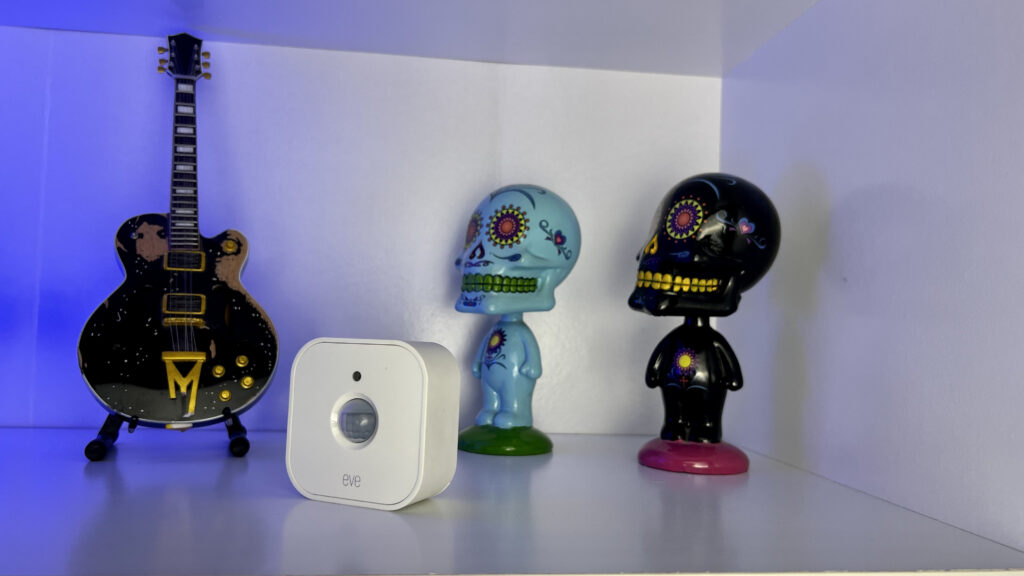Believe it or not, there’s quite a bit to consider when choosing the right HomeKit motion sensor. Reliability, range, configurability, features, velocity, and aesthetics all play a role in deciding which HomeKit motion sensor will get us to that ambient home control we’re all after. The newly-released second generation Eve Motion is definitely a step up from the previous model, but how does it stack up against competitors in the space?
Features
- PIR-baseed motion sensor
- Ambient light sensor
- Adjustable sensitivity up to
- Thread-enabled
Need to Knows
- IP X3 rating
- requires 2 AAA batteries
- requires Apple home hub (HomePod or Apple TV)
- Bluetooth backup
Pros
Thread is where it’s at these days and a motion sensor is the perfect application of it. While I have a couple of Bluetooth motion sensors that I still use, one of them being the first generation Eve Motion, and I do not personally mind the lag all that much for their applications, the increased speed and reliability that Thread brings to the new Eve Motion is pretty great and actually moves into the category of motion sensors that I can recommend.
As I have noticed when adding almost every other Thread device to my network, you’ll need to employ a bit of patience while the network reconfigures itself and gets to know its new friend. Once it does, however, speed and reliability are phenomenal and in my experience, just work.
There’s a lot of talk about it and Eve is definitely hyping the Motion’s IP rating. It is, after all, one of only 3 HomeKit motion sensors that are rated for outdoor use; the others being the pricey Hue outdoor motion sensor and, surprisingly the first generation Eve Motion. This fact alone could be a deciding factor when selecting a motion sensor. Don’t think, though, that you can submerge this HomeKit motion sensor in your pool to be notified of unwanted nocturnal skinny-dippers. It’s rated for splashes and light to moderate rain.
Moving on to the design, and this is absolutely a personal preference, but I don’t really mind it for most situations. Firstly, the smaller form factor over the previous iteration is definitely welcomed and actually makes it something I want to use inside my home. The dated design of the previous model was so bulky that I had a hard time putting it in an interior space where it didn’t stick out like a sore thumb.
It can be argued that the white plastic shell does not play well with the rest of Eve’s current design aesthetic, but it kind of does. Eve Motion and Door & Window are security-focused accessories and are meant to blend into their surroundings and those surroundings are usually indoors. While I do think an anodized aluminum framed sensor with black plastic would look super snazzy, I can’t necessarily say that I would want to speckle a corner of the ceiling in each room of my home with a black box and it definitely would draw more attention than an unassuming white one.
The new Eve Motion also boasts a lux sensor which I feel is vital to a motion sensor since the vast majority of users will employ it to control lights and/or window coverings. This again was something that was lacking in the initial offering and is very overdue.
Cons
Although a lot has changed and been upgraded and updated with the Eve Motion from its predecessor, one thing certainly hasn’t and that is its packaging. While it definitely protects the device and uses premium and recyclable materials, I cannot help but notice that there seems to be an excess of it. I must commend Eve for minimizing plastic in its packaging, but I would like to see Eve overhaul their packaging opting for a more conservative approach.
Similar to the first generation sensor, the v2 lacks in the mounting-diversity department. We get the standard keyhole hanging insert on the backside, but that’s it. A more adjustable and versatile mounting solution would have really put this over the top. I really like the flexibility of Hue’s magnetic screw mount and, though a little flimsy, the base of Aqara;’s motion sensors offer a great deal of flexibility to position the sensor just right.
The Apps

As is most always the case, Eve provides quite a few extra features for their products in their app, as opposed to the stock Apple Home feature set.
As is the case with Apple’s Home app, we can of course see if a motion is being detected, as well as the current light level in lux thanks to the built-in ambient light sensor. We also have access to the sensor’s current battery status and can modify in which room the device is located, as well as adjust the names for the two accessory services. On top of this, Eve’s app allows us to set the motion sensor’s sensitivity from high to low and it’s timeout duration between 5 seconds and 15 hours. Lastly, you can choose to toggle the LED to flash whenever motion is detected.
It seems a tad strange, but I was not able to find a historical graph or table of motion events in Eve’s app. This seems like something they would definitely offer and it may be there, but it’s either deeply hidden somewhere or inaccessible using VoiceOver. This being said, we do have easy access to at least the last time a motion event was detected.
The Eve app also serves up a HEALTHY amount of data regarding the Eve Motion’s participation in your Thread network. You can see information such as which router it is connecting through, its transport mode, and sleep interval.
E Eve app and Apple’s Home are based on motion being detected or stops being detected with time and people presence conditions. As is always the case, Eve’s app offers a more robust and customizable set of conditions for your automations. There’s not a lot to be said as for the Apple Home experience that hasn’t already been said. Automations in both th
Accessibility

I’ve been using Eve’s products since 2016 and they always get an A when it comes to accessibility, and the Eve Motion v2 is no exception. The battery compartment is easy to get at and this is nice considering that it is rated for outdoor use. The batteries are as easy to replace as anything and even the recessed reset button,which can be found between the gasket and the battery compartment itself, is fairly tactile.
The software experience is stellar with navigation being intuitive with headings support and buttons being clearly labeled and functional. The only caveat I have to this is whether or not any historical motion events data is available, however using VoiceOver, I got no indication that there could potentially be missing or inaccessible data.
Final Thoughts
I used, and still use, the original Eve Motion and it has been a trooper over the last 5+ years triggering my porch lights on at night and it will continue to serve this role until it no longer operates. The new version with Thread and the ambient light sensor however, is significantly more flexible and quickly jumped to the top of my recommended HomeKit motion sensors. It’s fast, reliable, has great range, and can now be more finely adjusted to control other smart accessories based on light levels. The only real downside is the limited mounting options. Despite this, it easily sits atop my list of the best HomeKit motion sensors. That is until it is dethroned…
We use income-earning affiliate links.
We may receive a small commission on purchases made using links on this page at no extra cost to you.




